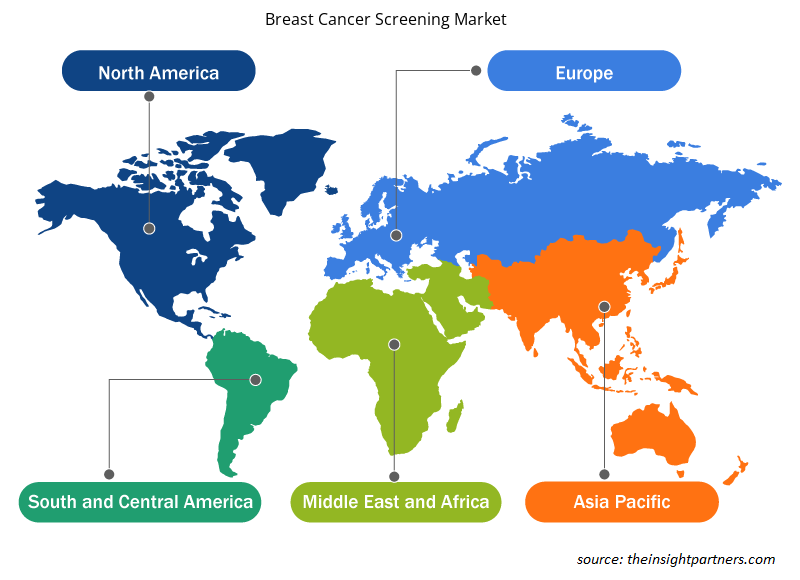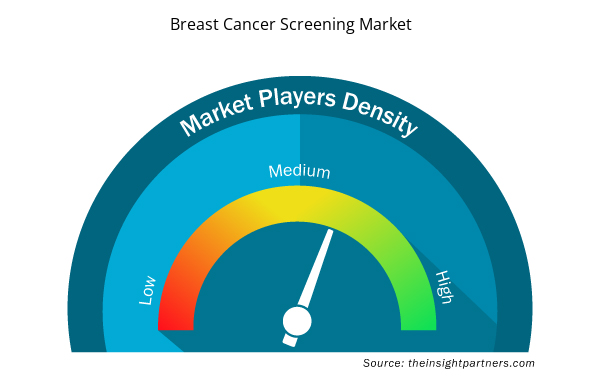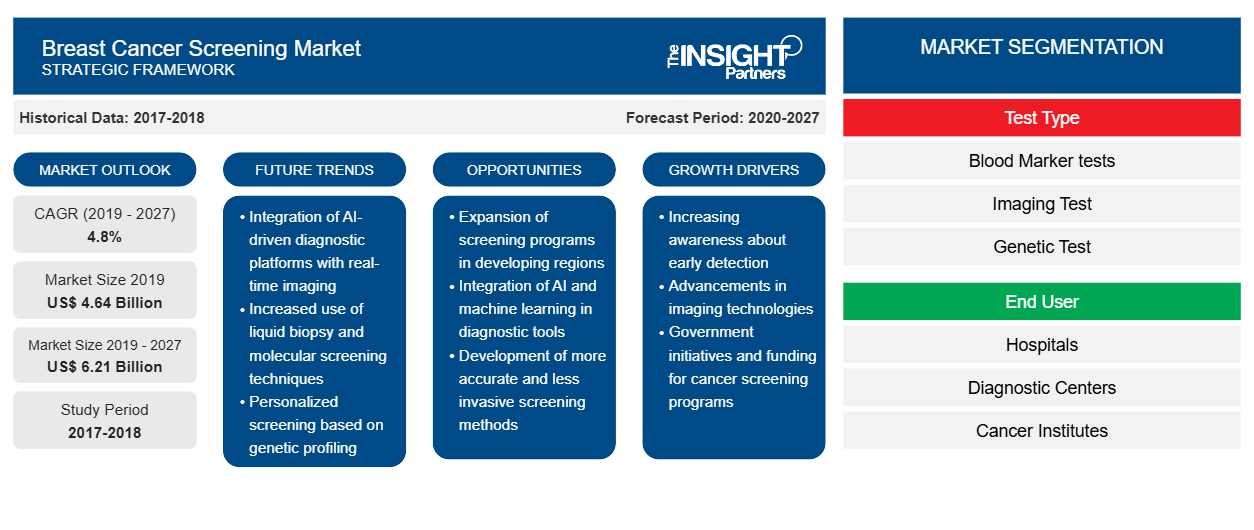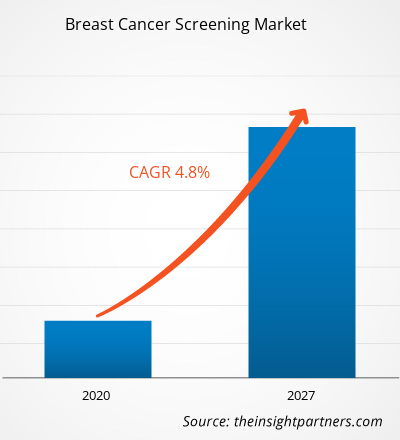[Forschungsbericht] Der Markt für Brustkrebs-Screening wird voraussichtlich von 4.638,63 Mio. USD im Jahr 2019 auf 6.209,25 Mio. USD im Jahr 2027 anwachsen; von 2020 bis 2027 wird ein durchschnittliches jährliches Wachstum von 4,8 % erwartet.
Brustkrebs ist die häufigste und am weitesten verbreitete Krebsart bei Frauen. Er entwickelt sich im Brustgewebe, normalerweise in den Milchgängen (Milchleitungen zur Brustwarze) und Läppchen (Milchdrüsen). Er kann auch im Fettgewebe oder Bindegewebe der Brüste auftreten. Eine frühe Diagnose von Brustkrebs ist wichtig, da sie verhindern kann, dass sich der Zustand verschlimmert, und eine erfolgreiche Behandlung sicherstellen kann. Zu den Screeningmethoden zur Diagnose von Brustkrebs gehören Mammographie, Magnetresonanztomographie (MRT), Ultraschall und andere. Das wichtigste Ziel des Screenings ist es, die Krankheit in ihrem frühesten und behandelbarsten Stadium zu erkennen. Die Screeningverfahren identifizieren die frühen Anzeichen von Krebs, noch bevor die Symptome auftreten.
Passen Sie diesen Bericht Ihren Anforderungen an
Sie erhalten kostenlose Anpassungen an jedem Bericht, einschließlich Teilen dieses Berichts oder einer Analyse auf Länderebene, eines Excel-Datenpakets sowie tolle Angebote und Rabatte für Start-ups und Universitäten.
- Holen Sie sich die wichtigsten Markttrends aus diesem Bericht.Dieses KOSTENLOSE Beispiel umfasst eine Datenanalyse von Markttrends bis hin zu Schätzungen und Prognosen.
Markteinblicke
Weltweit steigende Brustkrebsrate
Brustkrebs gehört zu den häufigsten Todesursachen weltweit und beeinträchtigt die Lebensqualität erheblich. Wird er nicht rechtzeitig diagnostiziert und behandelt, stellt er eine Belastung für die Gesellschaft dar. Nach Schätzungen der American Cancer Society ist Brustkrebs die häufigste Krebsart in den USA, da er 2018 bei ca. 234.087 Menschen an Brustkrebs erkrankte und zu 41.904 Todesfällen führte. Darüber hinaus werden im Jahr 2020 im Land ca. 276.480 Neuerkrankungen erwartet. Laut dem Globocan-Bericht 2019 gab es in Deutschland im Jahr 2018 insgesamt 71.888 Brustkrebsfälle, und die Krankheit führte in diesem Jahr zu ca. 19.376 Todesfällen. Darüber hinaus gab es laut dem Globocan-Bericht im Jahr 2018 in China ca. 367.900 Neuerkrankungen an Brustkrebs und 97.972 Todesfälle aufgrund dieser Erkrankung. In Indien legen NGOs, Regierungsbehörden und Wohltätigkeitsorganisationen großen Wert darauf, die Bevölkerung auf Brustkrebs aufmerksam zu machen, um eine frühzeitige Erkennung zu fördern, umfassende Behandlungsmodule bereitzustellen und die Unterstützung bei der Behandlung von Brustkrebs zu erweitern. Solche Initiativen sind eine Folge der zunehmenden Verbreitung dieser Krebsart im Land. Laut Schätzungen des Globocan-Berichts wurden in Indien im Jahr 2018 etwa 162.468 neue Fälle von Brustkrebs und 87.090 Todesfälle aufgrund dieser Erkrankung gemeldet. Diese zunehmende Verbreitung von Brustkrebs in verschiedenen Regionen der Welt führt zu einer weltweiten Nachfrage nach entsprechenden Screening-Geräten.
Testtypbasierte Markteinblicke
Der Markt für Brustkrebs-Screening ist nach Produkttyp in Blutmarkertests, bildgebende Tests, genetische Tests und immunhistochemische Tests unterteilt. Das Segment der bildgebenden Tests hatte 2019 den größten Marktanteil und wird im Prognosezeitraum voraussichtlich auch die höchste durchschnittliche jährliche Wachstumsrate (CAGR) auf dem Markt verzeichnen.
Endbenutzerbasierte Erkenntnisse
Auf der Grundlage des Endverbrauchers wurde der Markt für Brustkrebs-Screening in Krankenhäuser, Diagnosezentren, Krebsinstitute und Forschungslabore segmentiert. Das Segment Krankenhäuser hatte 2019 den größten Marktanteil, während das Segment Diagnosezentren im Prognosezeitraum voraussichtlich die höchste durchschnittliche jährliche Wachstumsrate (CAGR) auf dem Markt verzeichnen wird.
Produkteinführungen und -zulassungen sind eine häufig angewandte Strategie von Unternehmen auf dem Markt für Brustkrebs-Screening, um ihre Präsenz weltweit zu erweitern und der wachsenden Nachfrage durch die Erweiterung ihres Produktportfolios gerecht zu werden. Sie verfolgen auch die Expansionsstrategie, um ihren Kundenstamm weltweit zu vergrößern, was ihnen auch ermöglicht, ihren Markennamen weltweit aufrechtzuerhalten. So erhielt Siemens Healthineers im Juni 2017 die Zulassung der Food and Drug Administration (FDA) für das Produkt syngo.via VB20, das wahrscheinlich für die molekulare Bildgebung (MI) von Siemens Healthineers verwendet wird – eine neue Version der etablierten intelligenten Visualisierungssoftware des Unternehmens für multimodale Bildgebung.
Regionale Einblicke in den Brustkrebs-Screening-Markt
Die regionalen Trends und Faktoren, die den Brustkrebs-Screening-Markt im Prognosezeitraum beeinflussen, wurden von den Analysten von Insight Partners ausführlich erläutert. In diesem Abschnitt werden auch die Marktsegmente und die Geografie des Brustkrebs-Screenings in Nordamerika, Europa, im asiatisch-pazifischen Raum, im Nahen Osten und Afrika sowie in Süd- und Mittelamerika erörtert.

- Erhalten Sie regionale Daten zum Brustkrebs-Screening-Markt
Umfang des Marktberichts zur Brustkrebsvorsorge
| Berichtsattribut | Details |
|---|---|
| Marktgröße im Jahr 2019 | 4,64 Milliarden US-Dollar |
| Marktgröße bis 2027 | 6,21 Milliarden US-Dollar |
| Globale CAGR (2019 - 2027) | 4,8 % |
| Historische Daten | 2017-2018 |
| Prognosezeitraum | 2020–2027 |
| Abgedeckte Segmente | Nach Testtyp
|
| Abgedeckte Regionen und Länder | Nordamerika
|
| Marktführer und wichtige Unternehmensprofile |
|
Marktteilnehmerdichte: Der Einfluss auf die Geschäftsdynamik
Der Markt für Brustkrebs-Screening wächst rasant, angetrieben durch die steigende Nachfrage der Endnutzer aufgrund von Faktoren wie sich entwickelnden Verbraucherpräferenzen, technologischen Fortschritten und einem größeren Bewusstsein für die Vorteile des Produkts. Mit steigender Nachfrage erweitern Unternehmen ihr Angebot, entwickeln Innovationen, um die Bedürfnisse der Verbraucher zu erfüllen, und nutzen neue Trends, was das Marktwachstum weiter ankurbelt.
Die Marktteilnehmerdichte bezieht sich auf die Verteilung der Firmen oder Unternehmen, die in einem bestimmten Markt oder einer bestimmten Branche tätig sind. Sie gibt an, wie viele Wettbewerber (Marktteilnehmer) in einem bestimmten Marktraum im Verhältnis zu seiner Größe oder seinem gesamten Marktwert präsent sind.
Die wichtigsten auf dem Brustkrebs-Screening-Markt tätigen Unternehmen sind:
- Koninklijke Philips NV.
- HOLOGIC, INC.
- BD
- MYRIAD GENETICS, INC.
- SIEMENS HEALTHCARE GMBH
Haftungsausschluss : Die oben aufgeführten Unternehmen sind nicht in einer bestimmten Reihenfolge aufgeführt.

- Überblick über die wichtigsten Akteure auf dem Brustkrebs-Screening-Markt
Markt für Brustkrebs-Screening – nach Produkttyp
- Blutmarkertest
- Bildgebungstest
- Genetischer Test
- Immunhistochemischer Test
Markt für Brustkrebs-Screening – nach Anwendung
- Diagnostikzentren
- Krankenhäuser
- Forschungslabore
- Krebsinstitute
Brustkrebs-Screening – nach Geografie
- Nordamerika
- UNS
- Kanada
- Mexiko
- Europa
- Frankreich
- Deutschland
- Italien
- Vereinigtes Königreich
- Spanien
- Restliches Europa
- Asien-Pazifik
- China
- Indien
- Südkorea
- Japan
- Australien
- Restlicher Asien-Pazifik-Raum
- Naher Osten und Afrika
- Südafrika
- Saudi-Arabien
- Vereinigte Arabische Emirate
- Restlicher Naher Osten und Afrika
- Südamerika
- Brasilien
- Argentinien
- Restliches Südamerika
Firmenprofile
- Allgemeine Elektrizit?tsgesellschaft
- Siemens Healthineers AG
- Exact Sciences-Unternehmen
- Koninklijke Philips NV
- Hologic, Inc.
- BD
- Myriad Genetics, Inc.
- Oncocyte Corporation
- Danaher
- POC-Medizinsysteme
- Historische Analyse (2 Jahre), Basisjahr, Prognose (7 Jahre) mit CAGR
- PEST- und SWOT-Analyse
- Marktgröße Wert/Volumen – Global, Regional, Land
- Branche und Wettbewerbsumfeld
- Excel-Datensatz



Report Coverage
Revenue forecast, Company Analysis, Industry landscape, Growth factors, and Trends

Segment Covered
This text is related
to segments covered.

Regional Scope
North America, Europe, Asia Pacific, Middle East & Africa, South & Central America

Country Scope
This text is related
to country scope.
Häufig gestellte Fragen
The North American region holds the largest market for the breast cancer screening. The United States held the largest market for breast cancer screening mean market and is expected to grow due to factors such as increasing number of rising in prevalence of breast cancer, growing developments for screening and imaging process by the companies and others.
The diagnosis of breast cancer is done through breast cancer screening methods such as mammography, magnetic resonance imaging (MRI), ultrasound, and others. Screening examinations are tests performed for early diagnosis of the disease. The foremost goal of screening is to detect disease at its earliest and most treatable stage.
The growth of the market is attributed to some key driving factors such as increasing number of breast cancer cases, growing geriatric population and rising adoption of technology for screening purpose. However, high cost of screening method and bassinet on global business due to coronavirus pandemic are expected to restraint the growth of the market during the forecast years.
Trends and growth analysis reports related to Life Sciences : READ MORE..
The List of Companies - Breast Cancer Screening Market
- Koninklijke Philips N.V..
- HOLOGIC, INC.
- BD
- MYRIAD GENETICS, INC.
- SIEMENS HEALTHCARE GMBH
- Exact Sciences Corporation
- ONCOCYTE CORPORATION
- POC MEDICAL SYSTEMS
- Danaher
- GENERAL ELECTRIC
The Insight Partners performs research in 4 major stages: Data Collection & Secondary Research, Primary Research, Data Analysis and Data Triangulation & Final Review.
- Data Collection and Secondary Research:
As a market research and consulting firm operating from a decade, we have published and advised several client across the globe. First step for any study will start with an assessment of currently available data and insights from existing reports. Further, historical and current market information is collected from Investor Presentations, Annual Reports, SEC Filings, etc., and other information related to company’s performance and market positioning are gathered from Paid Databases (Factiva, Hoovers, and Reuters) and various other publications available in public domain.
Several associations trade associates, technical forums, institutes, societies and organization are accessed to gain technical as well as market related insights through their publications such as research papers, blogs and press releases related to the studies are referred to get cues about the market. Further, white papers, journals, magazines, and other news articles published in last 3 years are scrutinized and analyzed to understand the current market trends.
- Primary Research:
The primarily interview analysis comprise of data obtained from industry participants interview and answers to survey questions gathered by in-house primary team.
For primary research, interviews are conducted with industry experts/CEOs/Marketing Managers/VPs/Subject Matter Experts from both demand and supply side to get a 360-degree view of the market. The primary team conducts several interviews based on the complexity of the markets to understand the various market trends and dynamics which makes research more credible and precise.
A typical research interview fulfils the following functions:
- Provides first-hand information on the market size, market trends, growth trends, competitive landscape, and outlook
- Validates and strengthens in-house secondary research findings
- Develops the analysis team’s expertise and market understanding
Primary research involves email interactions and telephone interviews for each market, category, segment, and sub-segment across geographies. The participants who typically take part in such a process include, but are not limited to:
- Industry participants: VPs, business development managers, market intelligence managers and national sales managers
- Outside experts: Valuation experts, research analysts and key opinion leaders specializing in the electronics and semiconductor industry.
Below is the breakup of our primary respondents by company, designation, and region:

Once we receive the confirmation from primary research sources or primary respondents, we finalize the base year market estimation and forecast the data as per the macroeconomic and microeconomic factors assessed during data collection.
- Data Analysis:
Once data is validated through both secondary as well as primary respondents, we finalize the market estimations by hypothesis formulation and factor analysis at regional and country level.
- Macro-Economic Factor Analysis:
We analyse macroeconomic indicators such the gross domestic product (GDP), increase in the demand for goods and services across industries, technological advancement, regional economic growth, governmental policies, the influence of COVID-19, PEST analysis, and other aspects. This analysis aids in setting benchmarks for various nations/regions and approximating market splits. Additionally, the general trend of the aforementioned components aid in determining the market's development possibilities.
- Country Level Data:
Various factors that are especially aligned to the country are taken into account to determine the market size for a certain area and country, including the presence of vendors, such as headquarters and offices, the country's GDP, demand patterns, and industry growth. To comprehend the market dynamics for the nation, a number of growth variables, inhibitors, application areas, and current market trends are researched. The aforementioned elements aid in determining the country's overall market's growth potential.
- Company Profile:
The “Table of Contents” is formulated by listing and analyzing more than 25 - 30 companies operating in the market ecosystem across geographies. However, we profile only 10 companies as a standard practice in our syndicate reports. These 10 companies comprise leading, emerging, and regional players. Nonetheless, our analysis is not restricted to the 10 listed companies, we also analyze other companies present in the market to develop a holistic view and understand the prevailing trends. The “Company Profiles” section in the report covers key facts, business description, products & services, financial information, SWOT analysis, and key developments. The financial information presented is extracted from the annual reports and official documents of the publicly listed companies. Upon collecting the information for the sections of respective companies, we verify them via various primary sources and then compile the data in respective company profiles. The company level information helps us in deriving the base number as well as in forecasting the market size.
- Developing Base Number:
Aggregation of sales statistics (2020-2022) and macro-economic factor, and other secondary and primary research insights are utilized to arrive at base number and related market shares for 2022. The data gaps are identified in this step and relevant market data is analyzed, collected from paid primary interviews or databases. On finalizing the base year market size, forecasts are developed on the basis of macro-economic, industry and market growth factors and company level analysis.
- Data Triangulation and Final Review:
The market findings and base year market size calculations are validated from supply as well as demand side. Demand side validations are based on macro-economic factor analysis and benchmarks for respective regions and countries. In case of supply side validations, revenues of major companies are estimated (in case not available) based on industry benchmark, approximate number of employees, product portfolio, and primary interviews revenues are gathered. Further revenue from target product/service segment is assessed to avoid overshooting of market statistics. In case of heavy deviations between supply and demand side values, all thes steps are repeated to achieve synchronization.
We follow an iterative model, wherein we share our research findings with Subject Matter Experts (SME’s) and Key Opinion Leaders (KOLs) until consensus view of the market is not formulated – this model negates any drastic deviation in the opinions of experts. Only validated and universally acceptable research findings are quoted in our reports.
We have important check points that we use to validate our research findings – which we call – data triangulation, where we validate the information, we generate from secondary sources with primary interviews and then we re-validate with our internal data bases and Subject matter experts. This comprehensive model enables us to deliver high quality, reliable data in shortest possible time.


 Holen Sie sich ein kostenloses Muster für diesen Bericht
Holen Sie sich ein kostenloses Muster für diesen Bericht